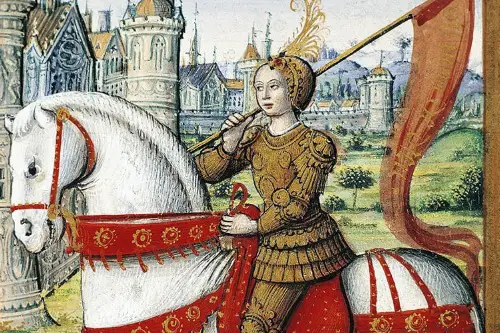Joan of Arc’s story has captivated the world for centuries—a tale of courage, faith, and extraordinary resilience. But beyond the layers of myth and legend lies a real girl who dared to defy the norms of her time. Let’s step into her shoes and explore how an ordinary teenager from a small French village transformed into a symbol of hope, a military leader, and ultimately, a martyr.
From Farm Girl to Warrior: Joan’s Humble Beginnings

Imagine a teenager tending to the fields, herding sheep, and hearing whispers of war in the distance. Joan of Arc, born in 1412 in Domrémy, France, was the daughter of a farming family. Life was simple yet challenging. Her world was shaped by the rhythms of village life and the shadow of a fractured France, embroiled in the Hundred Years’ War with England.
Joan wasn’t born into privilege or taught the ways of warfare. Instead, her remarkable journey began with a series of divine visions. According to Joan, saints and angels appeared to her, urging her to help save France and place the Dauphin, Charles VII, on the throne. Think about that for a moment: a teenage girl, no older than many high school students today, genuinely believed she was chosen by God to lead an army.
It’s easy to dismiss her conviction as the imagination of a devout adolescent, but Joan’s unwavering faith and determination were anything but ordinary. At just 16 years old, she defied societal expectations, leaving her home to present herself to Charles and persuade him to let her take charge. Picture the audacity required for a young girl with no political connections to walk into a royal court full of skeptical men—and convince them.
The Girl Who Led Armies: Joan’s Military Triumphs

Once she convinced Charles of her divine mission, Joan was given armor, a banner, and troops. Let’s pause here. The idea of a girl leading soldiers in the 15th century is astonishing. Medieval society was rigidly patriarchal. Women’s roles were confined to the home, the convent, or subservient positions. Yet, Joan not only commanded respect but inspired loyalty among battle-hardened men.
Her most famous victory came at the Siege of Orléans in 1429. France was on the brink of collapse, and Orléans was key to turning the tide of the war. Joan arrived with fresh troops and a bold strategy, rallying the demoralized French forces. She charged into battle, not as a passive observer but as an active participant, enduring injuries and motivating her men with her courage and conviction.
In just nine days, the French broke the siege, a moment that marked a turning point in the war. People began to believe in her divine mission, and her legend grew. Joan continued to lead successful campaigns, paving the way for Charles VII’s coronation in Reims—fulfilling the mission she had set out to accomplish.
Yet, despite her military success, Joan remained humble. Accounts from the time describe her as deeply devout, kind, and steadfast. She wasn’t driven by personal ambition; she simply wanted to obey what she believed was God’s will. Imagine the strength of character required to stay true to that purpose amid the chaos of war and the weight of an entire nation’s hopes resting on your shoulders.
Betrayal, Trial, and Legacy: Joan’s Tragic End

If Joan’s life were a storybook, this is where the happy ending would come in. But history isn’t always kind. After her victories, Joan’s influence began to wane. Political factions within France viewed her as a threat, and in 1430, she was captured by the Burgundians, allies of the English. Instead of being ransomed by the French, she was sold to the English and put on trial for heresy.
It’s hard to grasp the betrayal she must have felt. The same king she had fought to crown did nothing to save her. At just 19, Joan faced a sham trial, where her enemies twisted her words and condemned her for wearing men’s clothing—a necessity on the battlefield but deemed an unforgivable offense by her judges.
Her faith never faltered. Even as she was sentenced to burn at the stake, Joan remained steadfast. On May 30, 1431, in Rouen, she was executed. Witnesses reported that she asked for a crucifix to be held before her as she faced the flames, calling out the name of Jesus until her final moments.
Joan’s death was a tragedy, but it wasn’t the end of her story. Decades later, she was exonerated in a posthumous retrial, and in 1920, she was canonized as a saint. Today, she stands as a symbol of courage, faith, and the power of conviction.
Her story resonates because it’s deeply human. Joan was not a superhuman figure but a girl who believed she could make a difference—and did. She reminds us that bravery often means standing alone, defying the odds, and staying true to our beliefs, even when the world doubts us.
Joan of Arc’s life is a testament to the extraordinary potential within ordinary people. From her humble beginnings to her heroic military campaigns and her tragic end, she changed the course of history—not through wealth or power, but through sheer will and unwavering faith. As we look back on her story, we’re reminded that even the unlikeliest among us can rise to greatness. All it takes is the courage to believe in something bigger than ourselves.
